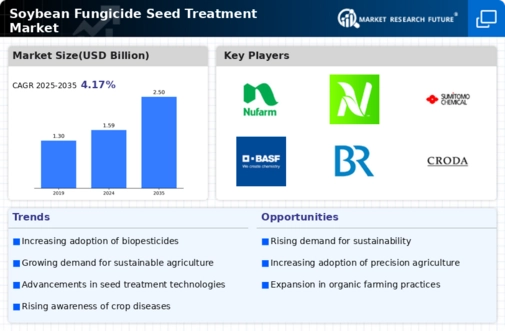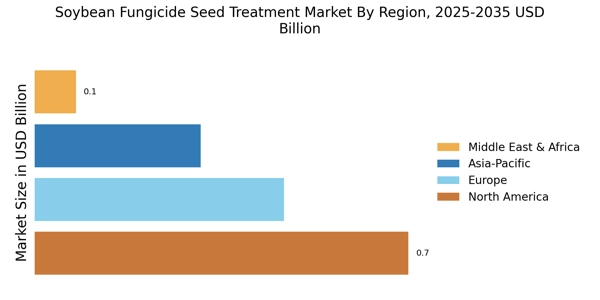Increased Awareness of Crop Health
There is a growing awareness among farmers regarding the importance of crop health and disease management, which significantly influences the Soybean Fungicide Seed Treatment Market. As agricultural practices evolve, farmers are becoming more educated about the impact of diseases on yield and quality. This awareness drives the adoption of fungicide seed treatments as a proactive measure to safeguard crops. In 2023, it was estimated that diseases could reduce soybean yields by up to 30%, prompting farmers to invest in preventive solutions. The emphasis on maintaining crop health aligns with sustainable agricultural practices, further propelling the demand for effective seed treatments. Consequently, the Soybean Fungicide Seed Treatment Market is likely to see increased investment as farmers prioritize crop protection.
Growing Demand for Soybean Products
The increasing global demand for soybean products, particularly in food and feed industries, drives the Soybean Fungicide Seed Treatment Market. As soybeans are a primary source of protein and oil, their cultivation has expanded significantly. In 2023, soybean production reached approximately 367 million metric tons, reflecting a robust growth trajectory. This surge in demand necessitates effective pest and disease management strategies, thereby enhancing the relevance of fungicide seed treatments. Farmers are increasingly adopting these treatments to ensure higher yields and quality, which is crucial in meeting the rising consumption needs. The Soybean Fungicide Seed Treatment Market is thus positioned to benefit from this trend, as growers seek solutions that can protect their crops from various fungal diseases, ultimately leading to improved profitability.
Rising Incidence of Fungal Diseases
The increasing incidence of fungal diseases affecting soybean crops is a critical driver for the Soybean Fungicide Seed Treatment Market. Reports indicate that diseases such as soybean rust and Phytophthora root rot have become more prevalent, threatening crop yields and quality. In recent years, the economic impact of these diseases has prompted farmers to seek effective solutions to mitigate losses. The market for fungicide seed treatments is projected to expand as growers recognize the necessity of protecting their crops from these threats. With the potential for yield losses reaching up to 50% in severe cases, the urgency for effective disease management solutions is evident. Thus, the Soybean Fungicide Seed Treatment Market is positioned to grow in response to these challenges.
Advancements in Seed Treatment Technologies
Technological innovations in seed treatment formulations are reshaping the Soybean Fungicide Seed Treatment Market. Recent advancements have led to the development of more effective and environmentally friendly fungicides that enhance seed protection. For instance, the introduction of nano-encapsulation techniques has improved the delivery and efficacy of active ingredients, allowing for lower application rates while maintaining effectiveness. This not only reduces the environmental impact but also lowers costs for farmers. The market for seed treatments is projected to grow at a compound annual growth rate of around 8% through 2025, indicating a strong shift towards these advanced solutions. As farmers increasingly recognize the benefits of these technologies, the Soybean Fungicide Seed Treatment Market is likely to experience significant growth.
Regulatory Support for Sustainable Agriculture
Regulatory frameworks promoting sustainable agricultural practices are increasingly influencing the Soybean Fungicide Seed Treatment Market. Governments and agricultural bodies are implementing policies that encourage the use of environmentally friendly pest management solutions. This regulatory support is crucial as it aligns with the global shift towards sustainable farming practices. For instance, initiatives aimed at reducing chemical residues in food products are prompting farmers to adopt seed treatments that comply with these regulations. The market for sustainable fungicides is expected to grow, with projections indicating a rise in market share for biopesticides and other eco-friendly solutions. As a result, the Soybean Fungicide Seed Treatment Market is likely to benefit from these regulatory trends, fostering innovation and adoption of sustainable practices.


















Leave a Comment